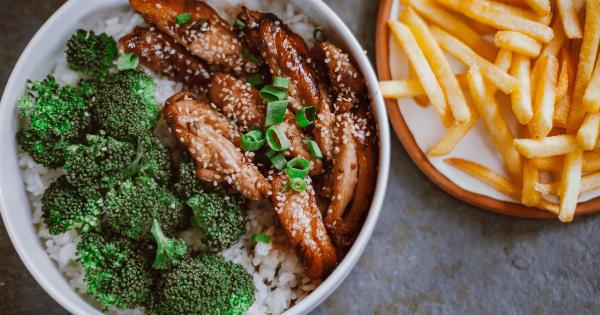Digestive disorders can affect anyone at any age. These disorders can range from minor discomfort to severe pain and can greatly impact an individual’s overall quality of life.
One such common digestive disorder is intestinal gas, which is caused by the accumulation of air or gases in the gastrointestinal tract. While some amount of intestinal gas is normal, excessive gas can lead to bloating, belching, flatulence, and even abdominal cramps.
In this article, we will explore digestive disorders related to intestinal gas and the foods that can cause or exacerbate this condition.
1. Irritable Bowel Syndrome (IBS)
IBS is a common digestive disorder that affects the large intestine. It is characterized by symptoms such as abdominal pain, bloating, constipation, and diarrhea. People with IBS often find that their condition worsens after consuming certain foods.
These trigger foods can vary from person to person but commonly include:.
- Beans
- Lentils
- Cabbage
- Onions
- Broccoli
These foods are known to produce excessive gas and ferment in the gut, leading to increased bloating and discomfort in individuals with IBS.
2. Lactose Intolerance
Lactose intolerance is the inability to digest lactose, a sugar found in milk and dairy products. When lactose is not properly digested, it can result in symptoms such as bloating, gas, diarrhea, and abdominal pain.
The following dairy products commonly cause intestinal gas in individuals with lactose intolerance:.
- Milk
- Ice cream
- Yogurt
- Cheese
While lactose intolerance can vary in severity, it is important to identify and avoid lactose-containing foods to reduce the risk of intestinal gas and other related symptoms.
3. Celiac Disease
Celiac disease is an autoimmune disorder triggered by the consumption of gluten, a protein found in wheat, barley, and rye. When individuals with celiac disease consume gluten, their immune system responds by damaging the lining of the small intestine.
Intestinal gas is a common symptom of celiac disease, along with diarrhea, abdominal pain, and weight loss. Avoiding foods containing gluten is vital for individuals with celiac disease. Such foods include:.
- Wheat-based products (bread, pasta, cereals)
- Barley
- Rye
- Beer
- Cakes and pastries
A gluten-free diet can help manage celiac disease symptoms and reduce the occurrence of intestinal gas.
4. High-Fiber Foods
Fiber is an essential part of a healthy diet as it aids in digestion and promotes regular bowel movements.
However, certain high-fiber foods can cause increased intestinal gas, particularly in individuals who are not accustomed to consuming adequate amounts of fiber. Some high-fiber foods that may cause gas include:.
- Whole grains
- Beans and legumes
- Cruciferous vegetables (cauliflower, Brussels sprouts, kale)
- Apples and pears (with skin)
- Prunes and prune juice
Incorporating fiber-rich foods into the diet gradually and ensuring adequate hydration can help minimize the occurrence of intestinal gas associated with high-fiber intake.
5. Carbonated Beverages
Carbonated beverages, such as soda and sparkling water, contain dissolved carbon dioxide gas. Consuming these drinks leads to the rapid accumulation of gas in the digestive system, resulting in bloating and excessive belching.
It is advisable to limit or avoid carbonated beverages, particularly for individuals who are prone to intestinal gas or digestive disorders.
6. Artificial Sweeteners
Artificial sweeteners are commonly used as sugar substitutes in beverages, desserts, and other processed foods. Some artificial sweeteners, such as sorbitol, xylitol, and mannitol, are known to be poorly absorbed in the digestive system.
As a result, they can ferment in the gut and cause intestinal gas and bloating in susceptible individuals. Checking food labels for artificial sweeteners and opting for natural sweeteners like stevia or consuming moderate amounts of sugar can help reduce the risk of excessive gas formation.
7. Fatty and Fried Foods
Fatty and fried foods can delay stomach emptying, leading to indigestion and an increased risk of intestinal gas. These foods also tend to be rich in calories and may contribute to weight gain, which can further exacerbate digestive disorders.
It is wise to limit the consumption of fried foods and opt for healthier cooking methods such as baking, grilling, or steaming.
8. Spicy Foods
Spicy foods, while flavorful, can irritate the gastrointestinal lining and cause symptoms such as heartburn, abdominal pain, and excessive gas.
Individuals with digestive disorders like gastroesophageal reflux disease (GERD) or peptic ulcers should avoid or minimize their intake of spicy foods to reduce discomfort and gas production.
9. Chewing Gum and Hard Candy
Chewing gum and hard candy may seem harmless, but frequent gum chewing or sucking on hard candy can lead to increased swallowing of air. As a result, excess air accumulates in the digestive system, leading to bloating and gas.
Minimizing the consumption of gum and hard candy can help reduce the risk of intestinal gas.
10. Onions and Garlic
Onions and garlic are widely used for their flavor-enhancing properties in various cuisines. However, both onions and garlic contain high levels of sulfur compounds, which can cause intestinal gas and strong-smelling flatulence.
Individuals who experience excessive gas or have digestive disorders may consider reducing or eliminating onions and garlic from their diet.
Conclusion
Intestinal gas is a common issue often associated with digestive disorders. By identifying and avoiding trigger foods, individuals can minimize the occurrence of uncomfortable symptoms such as bloating and excessive flatulence.
It is important to remember that what causes gas in one person may not affect another in the same way. Keeping a food diary or seeking guidance from a healthcare professional can help determine personal triggers and establish an individualized approach to managing intestinal gas.






























